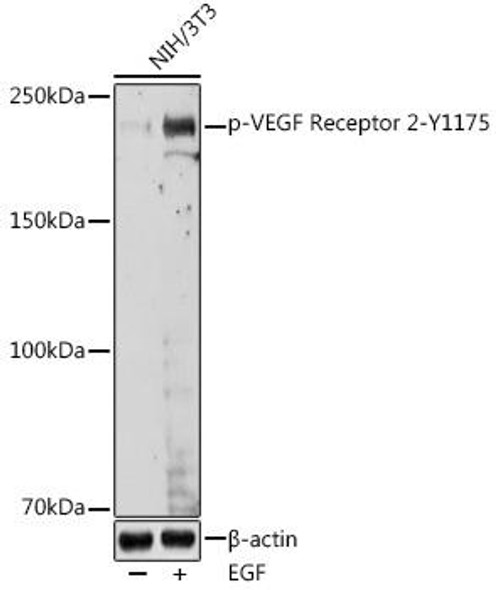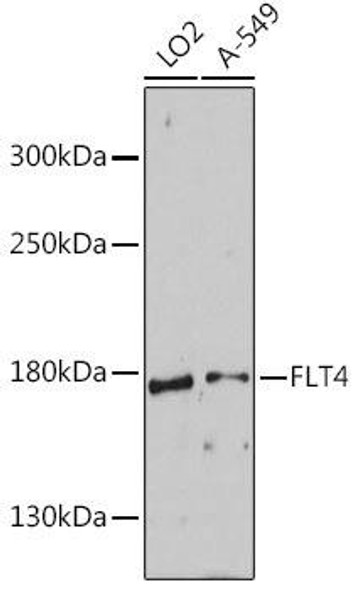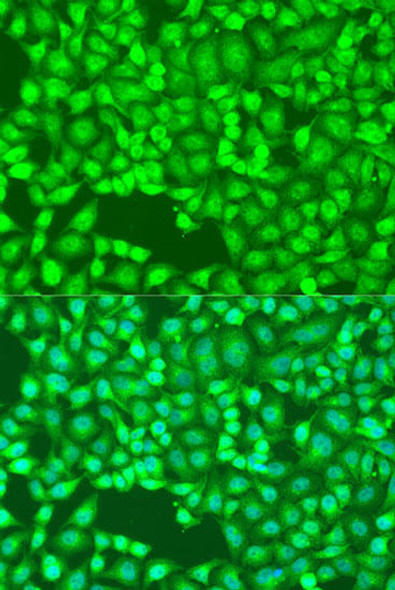Description
| Antibody Name: | Phospho-KDR/FLT4 (Y1054/Y1063) Antibody |
| Antibody SKU: | PACO04171 |
| Size: | 50ug |
| Host Species: | Rabbit |
| Tested Applications: | ELISA, IHC |
| Recommended Dilutions: | IHC:1:100-1:300 |
| Species Reactivity: | Human, Mouse, Rat |
| Immunogen: | synthesized peptide derived from human Flk-1/Flt-4 around the phosphorylation site of Y1054/Y1063. |
| Form: | Liquid |
| Storage Buffer: | Liquid in PBS containing 50% glycerol, 0.5% BSA and 0.02% sodium azide. |
| Purification Method: | The antibody was affinity-purified from rabbit antiserum by affinity-chromatography using epitope-specific immunogen. |
| Clonality: | Polyclonal |
| Isotype: | IgG |
| Conjugate: | Non-conjugated |
| Synonyms: | KDR; FLK1; VEGFR2; Vascular endothelial growth factor receptor 2; VEGFR-2; Fetal liver kinase 1; FLK-1; Kinase insert domain receptor; KDR; Protein-tyrosine kinase receptor flk-1; CD antigen CD309; FLT4; VEGFR3; Vascular endothelial growth |
| UniProt Protein Function: | VEGFR2: a receptor tyrosine kinase of the VEGFR family. High affinity receptor for VEGF and VEGF-C. Ligand binding induces autophosphorylation and activation. Activated receptor recruits proteins including Shc, GRB2, PI3K, Nck, SHP-1 and SHP-2. Plays a key role in vascular development and regulation of vascular permeability. |
| UniProt Protein Details: | Protein type:Protein kinase, TK; Kinase, protein; Membrane protein, integral; EC 2.7.10.1; Protein kinase, tyrosine (receptor); TK group; VEGFR family Chromosomal Location of Human Ortholog: 4q11-q12 Cellular Component: Golgi apparatus; endoplasmic reticulum; integral to plasma membrane; early endosome; cytoplasmic membrane-bound vesicle; extracellular region; plasma membrane; cell junction; nucleus; endosome; lipid raft; external side of plasma membrane Molecular Function:integrin binding; vascular endothelial growth factor receptor activity; protein binding; growth factor binding; protein-tyrosine kinase activity; receptor signaling protein tyrosine kinase activity; Hsp90 protein binding; transmembrane receptor protein tyrosine kinase activity; ATP binding Biological Process: extracellular matrix organization and biogenesis; positive regulation of positive chemotaxis; peptidyl-tyrosine phosphorylation; viral reproduction; protein amino acid autophosphorylation; cell maturation; calcium ion homeostasis; regulation of cell shape; positive regulation of MAPKKK cascade; positive regulation of focal adhesion formation; ovarian follicle development; positive regulation of cell proliferation; positive regulation of mesenchymal cell proliferation; angiogenesis; vasculogenesis; endothelial cell differentiation; cell fate commitment; embryonic hemopoiesis; positive regulation of phosphoinositide 3-kinase cascade; positive regulation of angiogenesis; cell migration during sprouting angiogenesis; branching morphogenesis of a tube; positive regulation of endothelial cell proliferation; positive regulation of protein amino acid phosphorylation; lymph vessel development; vascular endothelial growth factor receptor signaling pathway; alveolus development; surfactant homeostasis; transmembrane receptor protein tyrosine kinase signaling pathway; negative regulation of apoptosis; positive regulation of cell migration; positive regulation of nitric-oxide synthase biosynthetic process Disease: Hemangioma, Capillary Infantile |
| NCBI Summary: | Vascular endothelial growth factor (VEGF) is a major growth factor for endothelial cells. This gene encodes one of the two receptors of the VEGF. This receptor, known as kinase insert domain receptor, is a type III receptor tyrosine kinase. It functions as the main mediator of VEGF-induced endothelial proliferation, survival, migration, tubular morphogenesis and sprouting. The signalling and trafficking of this receptor are regulated by multiple factors, including Rab GTPase, P2Y purine nucleotide receptor, integrin alphaVbeta3, T-cell protein tyrosine phosphatase, etc.. Mutations of this gene are implicated in infantile capillary hemangiomas. [provided by RefSeq, May 2009] |
| UniProt Code: | P35968 |
| NCBI GenInfo Identifier: | 9087218 |
| NCBI Gene ID: | 3791 |
| NCBI Accession: | P35968.2 |
| UniProt Secondary Accession: | P35968,O60723, Q14178, A2RRS0, B5A925, C5IFA0, |
| UniProt Related Accession: | P35968 |
| Molecular Weight: | 79,634 Da |
| NCBI Full Name: | Vascular endothelial growth factor receptor 2 |
| NCBI Synonym Full Names: | kinase insert domain receptor (a type III receptor tyrosine kinase) |
| NCBI Official Symbol: | KDR |
| NCBI Official Synonym Symbols: | FLK1; CD309; VEGFR; VEGFR2 |
| NCBI Protein Information: | vascular endothelial growth factor receptor 2; soluble VEGFR2; fetal liver kinase 1; fetal liver kinase-1; protein-tyrosine kinase receptor Flk-1; tyrosine kinase growth factor receptor |
| UniProt Protein Name: | Vascular endothelial growth factor receptor 2 |
| UniProt Synonym Protein Names: | Fetal liver kinase 1; FLK-1; Kinase insert domain receptor; KDR; Protein-tyrosine kinase receptor flk-1; CD_antigen: CD309 |
| Protein Family: | Vascular endothelial growth factor receptor |
| UniProt Gene Name: | KDR |
| UniProt Entry Name: | VGFR2_HUMAN |






